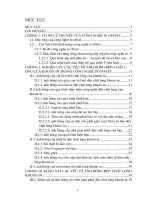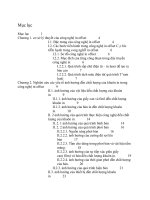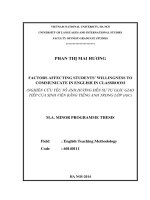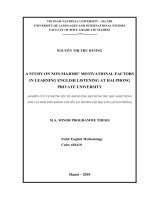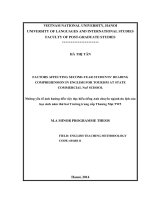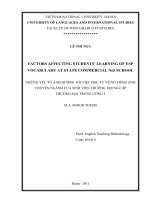Factors affecting second-year students’ reading comprehension in English for Tourism at State Commercial No5 School = Những yếu tố ảnh hưởng đến việc đọc hiểu t
Bạn đang xem bản rút gọn của tài liệu. Xem và tải ngay bản đầy đủ của tài liệu tại đây (527.09 KB, 62 trang )
VIETNAM NATIONAL UNIVERSITY, HANOI
UNIVERSITY OF LANGUAGES AND INTERNATIONAL STUDIES
FACULTY OF POST-GRADUATE STUDIES
*********************
HÀ THỊ TÂN
FACTORS AFFECTING SECOND-YEAR STUDENTS’ READING
COMPREHENSION IN ENGLISH FOR TOURISM AT STATE
COMMERCIAL No5 SCHOOL
Những yếu tố ảnh hưởng đến việc đọc hiểu tiếng Anh chuyên ngành du lịch của
học sinh năm thứ hai Trường trung cấp Thương Mại TW5
M.A MINOR PROGRAMME THESIS
FIELD: ENGLISH TEACHING METHODOLOGY
CODE: 60140111
Hanoi, 2014
VIETNAM NATIONAL UNIVERSITY, HANOI
UNIVERSITY OF LANGUAGES AND INTERNATIONAL STUDIES
FACULTY OF POST-GRADUATE STUDIES
*********************
HÀ THỊ TÂN
FACTORS AFFECTING SECOND-YEAR STUDENTS’ READING
COMPREHENSION IN ENGLISH FOR TOURISM AT STATE
COMMERCIAL No5 SCHOOL
Những yếu tố ảnh hưởng đến việc đọc hiểu tiếng Anh chuyên ngành du lịch của
học sinh năm thứ hai Trường trung cấp Thương Mại TW5
M.A MINOR PROGRAMME THESIS
FIELD: ENGLISH TEACHING METHODOLOGY
CODE: 60140111
SUPERVISOR: NGUYỄN THỊ MINH TÂM, PhD.
Hanoi, 2014
i
CANDIDATE’S STATEMENT
I hereby certify that the thesis entitled
Factors affecting second-year students' reading comprehension in
English for Tourism at State Commercial No5 School
is the result of my own research for the degree of Master of Arts at University of
Languages and International Studies- VNU, and that this thesis has not been
submitted for any degree at any other university or tertiary institution.
Hanoi, 2014
Student‟s signature
Hà Thị Tân
ii
ACKNOWLEDGEMENTS
First of all I would like to express my sincere and deep gratitude to my
supervisor, Dr. Nguyễn Thị Minh Tâm for her wholehearted guidance, invaluable
advice, constructive criticism and encouragement in the completion of my research
work.
I am grateful to all lecturers and the staff of the Faculty of Post-Graduate
Studies at University of Languages and International Studies-VNU for their useful
lectures and guidance during my study.
My sincere thanks also go to my colleagues and students at State
Commercial No5 School, who provided me with inspiration for the research topic
and helped me with the research data.
Last but not least, I would like to thank my family and dear friends for their
support and encouragement.
iii
ABSTRACT
In learning English for General Purposes (EGP) in general and English for
Specific Purposes (ESP) in particular, reading plays an important role. In
comparison with writing, speaking and listening, reading will be used most often in
the students‟ future work, especially reading ESP. However, learning reading is
really the greatest challenge in learning a foreign language because learning reading
involves a number of cognitive processes and it is affected by a number of factors.
The aims of this study are to identify the factors affecting second-year
students' reading comprehension in English for Tourism at State Commercial No5
School (SCS) and suggest possible solutions to help students study ESP reading
more effectively.
The study was undertaken with 50 second-year students of Tourism and three
ESP teachers at SCS. The data show that the major factors affecting second-year
students' reading comprehension in English for Tourism are reading skills,
language, cultural background knowledge and reading habits and motivation. Some
solutions are suggested to deal with these factors including increasing students‟
interest and motivation in reading, training students to become readers with efficient
reading skill, encouraging students to develop extensive reading habit and
motivation, giving homework and checking the previous lessons frequently,
improving teachers‟ professional knowledge, helping students to improve their
cultural knowledge and developing the reading materials.
It is hoped that the result of this study will help students and teachers at SCS
learn and teach ESP reading in general, reading English for Tourism in particular
more effectively.
iv
LIST OF ABBREVIATIONS
ESP: English for Specific Purposes
EGP: English for General Purposes
EFL: English as a Foreign Language
ELT: English Language Teaching
L1: First Language
L2: Second Language
SCS: State Commercial No5 School
v
LIST OF CHARTS &TABLES
Chart 1: Students‟ attitude towards ESP reading.
Chart 2: Students‟ attitude towards the importance of the reading skill.
Chart 3: Students‟ attitude towards the necessity of reading English for tourism for
their future job.
Table 1: Framework of factors that affect students‟ ESP reading
Table 2: Students‟ frequency of reading supplementary materials
Table 3&4: Students‟ evaluation of the texts in the current ESP reading material
Table 5: Students‟ views of sources of difficulties in reading English for Tourism
Table 6: Activities the teachers ask the students to do at pre-reading stages.
Table 7: Activities the teachers ask the students to do at post-reading stages
vi
TABLE OF CONTENTS
Candidate‟s statement i
Acknowledgements ii
Abstract. .iii
List of abbreviations .iv
Lists of Charts and Tables. v
Table of contents vi
PART A: INTRODUCTION 1
1. Rationale. 1
2. Aim of the study. .2
3. .Research questions. 2
4. Scope of the Study 2
5. Methods of the study 2
6. Organization of the study 3
PART B: DEVELOPMENT 4
Chapter I: LITERATURE REVIEW. 4
1.1. Reading and reading comprehension 4
1.1.1. Definition of reading 4
1.1.2. Reading comprehension 5
1.2. ESP reading 6
1.2.1. Definition of ESP 6
1.2.2. Reading skills in ESP 7
1.3. Factors affecting students‟ reading comprehension in ESP 8
1.3.1. Reading skill factor 9
1.3.2. Language factor 9
1.3.3. Cultural background knowledge factor 10
1.3.4. Reading habit and motivation factor 11
1.4. Review of previous studies 13
vii
1.5. Summary 14
CHAPTER II: METHODOLOGY 15
2.1. The context of the study 15
2.1.1. The teachers of English and their methods of teaching 15
2.1.2. The students and their background 15
2.1.3. The teaching materials 16
2.2 The study 16
2.2.1. Research questions 16
2.2.2. Data collection instruments and procedure 17
2.2.2.1. Questionnaires for students (a,b,c,d) 17
2.2.2.2. Interview questions for teachers (a,b,c,d) 18
CHAPTER III: FINDINGS AND DISCUSSION 20
3.1. Answers to research question 1 20
3.2. Answers to research question 2 24
3.2.1. To what extent does reading skill factor affect students‟ learning reading? 26
3.2.2. To what extent does language factor affect students‟ learning reading? 27
3.2.3. To what extent does cultural background knowledge factor affect students‟
learning reading? 28
3.2.4 To what extent does reading habit and motivation factor affect students‟
learning reading? 29
3.3. Suggestions for improving students‟ reading ability 29
3.3.1. Increasing students‟ interest and motivation in reading. 31
3.3.2. Training students to become readers with efficient reading skill 31
3.3.3. Encouraging students to develop extensive reading habit 33
3.3.4. Giving homework and checking the previous lessons frequently 34
3.3.5. Improving teachers‟ professional knowledge 34
3.3.6. Helping students to improve their cultural knowledge 35
3.3.7. Developing the reading materials 35
PART C: CONCLUSION 36
viii
1. Recapitulation 36
2. Pedagogical implication 37
3. Limitations of the study 37
4. Suggestions for further study 38
REFERENCES 39
APPENDICES
Appendix 1: Questionnaire for students (in English) I
Questionnaire for students (in Vietnames) V
Appendix 2: Interview questions for teachers. VIII
Appendix 3: Interview notes IX
1
PART A: INTRODUCTION
1. Rationale
Learning English now is not only an interest but also a practical thing for
many people. Learning English means learning four related skills: listening,
speaking, reading and writing. In teaching and learning English as a foreign
language in Vietnam, reading has always received a great deal of attention. This is
understandable because English is taught and learnt in non-English environment, so
reading is not only the important means to get knowledge but also means of further
study.
From the early 1960‟s, English for Specific Purpose (ESP) has grown to
become one of the most prominent areas of English as a Foreign Language (EFL)
teaching today. Hutchinson and Waters (1987) defines ESP as an approach to
language teaching in which all decisions as to content and method are based on the
learner‟s reason for learning. In ESP, it is a need analysis that determines which
language skills are most needed by the students and the syllabus is designed
accordingly. During the last few decades, ESP has been developing vigorously for
the reasons that there has been an increase in vocational training and learning
throughout the world and the spread of globalisation has resulted in the increasing
use of English as the language of international communication, more and more
people are using English in a growing number of occupational contexts. In teaching
and learning English as a foreign language in Vietnam, ESP has recently received a
great deal of attention.
In the context of State Commercial No5 School (SCS), English is a
compulsory subject to the students. They have to learn ESP at the beginning of the
second year. With limited knowledge of vocabulary and English grammar, it is
difficult for students to study ESP, especially ESP reading. The students often
complain that they do not know how to read the text effectively. Despite the efforts
of the teachers, students‟ reading proficiency is still low. With some years of
experience in teaching ESP, the researcher recognizes that there are many factors
2
that effect the teaching and learning process such as inappropriate teaching methods
and classroom techniques, inappropriate attitudes of teachers and the students
towards the subject, inappropriate teaching materials.
With an attempt to improve the students‟ reading proficiency, this study is
aimed at finding out the factors that most affect second-year students for Tourism at
SCS and the cause of those factors as the first step to the pedagogical solutions. I
believe that these solutions would be based on the understanding of what the
students find most challenging to them while reading English texts and why they
find it challenging.
2. Aim of the study
The study is aimed at finding out the factors affecting second-year students'
reading comprehension in English for Tourism at SCS. Once these factors have
been identified, solutions to help students study ESP reading more effectively will
be suggested.
3. Research questions
The research is carried out with an attempt to find out answers to the following
research questions:
1. What are the factors that affect second-year students' reading comprehension
in English for Tourism at SCS?
2. To what extent do those factors influence second-year students' reading
comprehension in English for Tourism at SCS?
4. Scope of the study
Because of the limited time, the study merely focuses on ESP reading factors
that effect students of tourism at SCS. Then some solutions are made to improve the
quality of teaching and learning ESP reading.
5. Method of the study
In order to achieve the aims mentioned above, the major method used in the
study is the qualitative. Two data collecting instruments are survey questionnaire
and interview. The survey questionnaire with 10 questions (See Appendix 1) was
3
designed for tourism students to identify their opinions on reading lessons, the
factors affecting their comprehension in an English text for Tourism and to find out
their expectation to achieve better reading competence. The interviews with 9
questions (See Appendix 2) were conducted for data triangulation for the
questionnaire and to seek for teachers‟ explanation about why and how, through
their teaching methodology, the four factors: reading skill, language, cultural
background, and reading habit and motivation can influence their students‟ learning
of reading.
6 Organization of the study
The study is organized into three main parts:
Part I: Introduction presents the rationale for choosing the topic of the study,
the aims, research questions, the methods, the scope and the organization of the
study.
Part II: Development includes three chapters:
- Chapter I: Theoretical background and Literature review
- Chapter II: Methodology
- Chapter III: Findings and Discussion
Part III: Conclusion gives a recapitulation of the study, pedagogical
implication, limitations and suggestions for further study.
4
PART B: DEVERLOPMENT
Chapter I: LITERATURE REVIEW
1.1. Reading and reading comprehension
1.1.1. Definition of reading
It is stated that reading is a kind of culture that people regardless of age, sex,
or class should learn and have. Although no one can deny the high frequency of
reading in daily life, many people do not fully understand thoroughly what reading
or reading comprehension. There have been so many definitions of reading that they
cause much confusion. However, no single definition or explanation can live up to
everyone‟s satisfaction.
According to Goodman (1971:135), reading is “a psycholinguistics process
by which the reader - a language user, reconstructs, as best as he can, a message
which has been encoded by a writer as a graphic display”. For Goodman, this act of
reconstruction is considered as a cyclical process of sampling, predicting, testing,
and confirming. To make the matter simple and easy, from the motor-psychological
perspective, Harmer (1989:153) considers reading as a mechanical process that
“eyes receive messages and the brain then has to identify the meanings of those
messages”. So the speed of reading depends much on the mechanical process of
looking and perceiving and it is the reader who decides how fast he wants to read
the text.
From a cognitive perspective, Smith defines that “reading is to understand
author‟s thought” (Smith, 1985:102). But the problem posed hereof is that how the
reader understands the written texts because the meanings of a word depend on the
context in which it appears. The closer the reader shares the context with the author,
the more he/she can understand what the author wants to say through the message.
This mostly depends on the reader‟s reading proficiency.
It is clear that reading is defined from a variety of perspectives:
psychological, motor-psychological, cognitive, and interactive. Therefore, no
5
definition can possibly capture all the ideas and features of what reading is. Each
scholar‟s definition reflects what reading means as seen from his point of view.
However, what they all share is that they try to find out the nature of reading, and
reading act, in which the readers, reading process and reading messages are
emphasized.
1.1.2. Reading comprehension
Reading comprehension plays a very important part in teaching and learning
reading a language and a foreign language as well. It can be seen as the ability to
retain information of a written text to the fullest of the readers. Grellet defines that
“reading comprehension or understanding a written text means extracting the
required information from it as effectively as possible” (Grellet, 1981:34). From this
point of view, Grellet focuses on readers‟ ability of understanding the meaning of a
written text based on the individual‟s background knowledge. Having the same
point of view with Grellet, Swan states that “A student is good at comprehension we
mean that he can read accurately and efficiently, so as to get the maximum
information of a text with the minimum of understanding” (Swan, 1975: 1). This
means that the student can show his understanding by re-expressing the content of
the text in many ways such as summarizing the text, answering questions, etc.
For a little more different definition of reading comprehension, Richards and
Rodgers (1986) put their emphasis on the share of opinion between the author and
the reader. So according to them, “reading comprehension is best described as an
understanding between the author and the reader” (Richards and Rodgers, 1986:7).
This implies that during the reading process, readers on the way to discover what
the author means and to build meaning for themselves at the same time in their own
language, their thoughts, and their own view of the world based on their background
knowledge. It is very difficult, even impossible to understand the author‟s meaning
to the maximum if there is no interaction between the author and the reader about
language and thoughts. Consequently, the reader is as active in searching for
meaning as is the writer in creating written language.
6
To sum up, reading comprehension plays a very important role in teaching
and learning a foreign language in general and teaching reading in particular.
However, the reasons for reading differ from one person to another. As a result, the
ways we read are also different. In other words, the purposes of reading determine
the ways or the styles of reading. Now it is necessary to identify the factors
involved in the reading comprehension to have a closer look at reading
comprehension.
1.2. ESP reading
1.2.1. Definition of ESP
What is ESP? This is a big and complicated question that requires much
effort in seeing how ESP at the present relates to the rest of English Language
Teaching (ELT). If we take a look at the tree of ELT (Hutchinson and Waters,
1987:17), it is clear that ESP is a big multi-levels branch of ELT being nourished by
the learning and communication roots. Hutchinson and Waters regards it as “an
approach to language teaching in which all decisions as to content and method are
based on the learners‟ reason for learning” (Hutchinson and Waters, 1987:17). ESP
must be seen as an approach not as a product and is directed by specific and
apparent reasons for learning ESP. Students' goal of 1earning a second 1anguage
might acquire not only general linguistics competencies but also academic and job-
related skills.
Strevens (1988:1), by contrast, states that “ESP is a particular case of the
general category of special - purpose language teaching”. In his work, he points out
four following absolute characteristics of ESP:
+ ESP is designed to meet the learners‟ specified needs.
+ ESP has the content relating to particular disciplines, occupations and activities.
+ ESP is centered on language appropriate to those activities in syntax, lexis,
discourse, semantics, and analysis of the discourse.
+ ESP is in contrast with General English
7
In order to make the above mentioned absolute characteristics of ESP
distinctive, other two variable characteristics are set up. Firstly, ESP may be
restricted to skills to be learnt (for example reading only). Secondly, ESP may not
be taught according to any pre-ordained methodology. All of the characteristics of
ESP make us come to an end that teaching and learning ESP is a challenging task
for both teachers and students.
Widdowson (1983:5) argues that the purpose for ESP and EGP is the same,
but he clearly points out that what distinguishes ESP from EGP is “the way in
which purpose is defined and the manner of its implementation”. He further
distinguishes the two by their differences in relation to education and training. The
design of ESP is based as precisely as possible on what learners need. Courses are
designed to provide learners with the restricted competence they need to cope with
certain clearly specified set of tasks.
From the above mentioned viewpoints, when dealing with ESP, it is
necessary to identify two central areas in ESP which are content and methodology.
In terms of content, it is important to concern about the scope of a particular course
in comparison with the totality of the language to make the ESP course balanced in
content so that it is not either too narrow or broad. In terms of methodology, ESP
courses aim to develop linguistic skills relating to particular spheres of activity, not
only the nature of the linguistic items introduced, but the ways in which they are
introduced and how they are practised. So it is also crucially important for teachers
to apply good methods in ESP classes because good methods decide most of the
success of the classroom.
1.2.2. Reading skills in ESP
According to Hutchinson and Waters (1987:17), ESP “is an approach to
language teaching in which all decisions as to content and method are based on the
leaner‟s reason for learning”. An ESP course therefore should differ from an EGP
course in its selection of skills and themes, topics, situations and functions. What is
more, all courses have purposes and aims to achieve. All courses should be based
8
on an analysis of the students‟ needs and meet students‟ needs. ESP reading
normally receives more attention.
There is another significant contribution to teaching reading on ESP courses:
the recognition that good reading requires language and skills, which has been
shown by many researchers (Alderson, 1984). Learners need to reach a threshold
level of language knowledge before they are able to transfer any L1 skills to their
L2 reading tasks. Therefore, the reading component of an ESP course requires a
balance between skills and language development. Dudley-Evans and St.John
(1998: 134) show some of the key skills:
- selecting what is relevant to the current purpose
- using all the features of the text such as headings, layout, typeface
- skimming for content and meaning.
- scanning for specifics
- identifying organizational patterns.
- understanding relations within a sentence and between sentences.
- using cohesive and discourse markers.
- predicting, interfering and guessing.
- identifying main ideas, supporting ideas and examples.
- processing and evaluating the information during reading.
- transferring or using the information while or after reading.
1.3. Factors affecting students’ reading comprehension in ESP
Reading in a foreign language is important to personal development,
professional success and academic studies. However, in learning reading especially
in ESP reading, there are many factors affecting reading success such as reader‟s
reading habits, attitude, motivation, exposure to the target language, textual
characteristics, the way reading is taught and the teacher‟s classroom techniques or
learning environment, etc. In this study, I base myself on the previous studies by
9
Jolly (1978), Coady (1979), Yorio (1971) and others indicate that factors effecting
foreign language reading may lie either on learners‟ reading skills, language
proficiency , cultural and background knowledge or reading habit and motivation.
1.3.1. Reading skill factor
According to Jolly (1978), one‟s first language reading ability plays a more
important role in reading success than his level of the target language does because
foreign language reading requires the transference of old skills, not the learning of
new ones. This view is shared by Coady (1979) who confirms that foreign language
reading is a reading skill problem, not a language problem.
Bernhard (1995:17) states “reading performance in a second language is
largely shared with reading ability in a first language”. Sharing this opinion, Sarid
assumed that “the same reading strategies types accounted for success and failure in
both languages to almost the same extent”.
It can be seen clearly that student‟s limited reading skills create many
problems. Frequently they read text in a foreign language at a slower speed than in
their first language. Moreover, they do not know how to read in the appropriate
ways. They just look at every single word, read slowly from the beginning to the
end and, consequently, fail to grasp the general meaning of the passage. Sometimes,
they may encounter a lot of unfamiliar vocabularies, a long text or an unfamiliar
topic, yet they can not concentrate well on the text and when they get to the last
paragraph, they may not be able to recall what they have read in the first ones.
1.3.2. Language factor
Yorio (1971) argues that reading problems of foreign language learners are
largely due to the knowledge of the target language and the mother tongue
interference in the reading process. In his opinion, reading involves four factors:
knowledge of the language, ability to guess so as to make the correct choice, ability
to remember the previous cues, and ability to make necessary association between
the different cues that have been selected. Therefore, learners with limited
knowledge of the target language may face with considerable difficulties when
10
reading in the target language. This view is supported by other researchers
(Alderson; 1984 and Clarke; 1980). They acknowledge that a lack of appropriate
linguistic knowledge constrains the transfer of reading skills and strategies from L1
to L2.
Besides, readers have to face various difficulties. The first and the foremost
problem is that they may have to work with unfamiliar and difficult topics. These
are called “text problems”. The content of the text might be rather strange to the
students and the grammatical structures might be new. Therefore, they can not
understand it. The readers will find the text very challenging and might not have
any motivation left to keep on reading. L2 readers may have difficulty adjusting
their reading strategies to match the author‟s intent or purpose. They may not be
familiar with a particular story “grammar” or the organizational patterns of
informational text. They may not be familiar with specific genre and the literary
devises used in text.
The second but not less important kind of problem is the “vocabulary
problems”. As everyone knows, grammatical knowledge accounts for a great deal of
competence in reading. However, knowledge of vocabulary is a great deal more
important as a factor to reading comprehension than awareness of grammatical
structures (O‟Donnel, 1961: 313-316). L2 readers may lack knowledge of English
grammar and syntax and, therefore, may read word by word. They may encounter
too much unfamiliar vocabulary which hinder their grasp of the overall concept
conveyed in the sentence. They are also challenged when reading idiomatic
expressions and unfamiliar grammatical constructions.
1.3.3. Cultural background knowledge factor
Several studies on reading skills indicate that apart from language problems
and reading skill problems, cultural knowledge can also affect students‟ reading
ability.
Strang (1972) states that readers will have different levels of comprehension
11
of the same text because they start off from different positions. They interpret texts
differently because of the differences in the high-level cultural schemata that were
activated.
Many studies including Steffensen et al (1979) and Carrell (1981) have
demonstrated the effect of cultural knowledge on the product of comprehension.
Appealing to the processes of distortion and elaboration to account for the
differences between a recall of text and the original text. Readers facing with
unfamiliar cultural contents may mistranslate or misinterpret the text according to
their own cultural experiences. Reading comprehension is a function of cultural
background knowledge. If readers possess the schemata assumed by the writer, they
understand what is stated and effortlessly make the inferences intended. As Hudson
(1982:9) states: “the reading problems of the L2 readers are not due to an absence of
attempts at fitting and providing specific schemata. Rather, problem lies in
projecting appropriate schemata”
To conclude, in most cases, reading and understanding a text is often a
challenging task for a reader during a reading process if he/she does not have full
background knowledge of the subject matter, his/her low reading speed is low to
keep pace with other better students‟, the topics are unfamiliar, and he has not
enough reading strategies in hand, etc. All of those difficulties prevent him/her from
understanding to the fullest the writer‟s purposes and ideas and lead to decrease in
reading motivation. So it is necessary to create learners‟ interest, enhance their
motivation in teaching reading
1.3.4. Reading habit and motivation factor
Motivation plays a crucial role not only in second language learning but also
in reading comprehension. Reading behaviors are influenced by motivation across
cultures and languages. It is said that readers‟ motivation has an effect not only on
the result of comprehension but also upon the process of understanding. If the
readers have no interest in the text, it means that they do not want to read than the
12
reading activity will become a pressure to themselves and even the reading process
may not happen at all.
In the case readers are motivated to read, they will start reading the texts to
satisfy their desire, to find a number of questions and specific information or ideas
they are interested in. A great deal of conducted studies on the motivation of second
language readers have shown that poor readers usually lack motivation to read and
make efforts to improve their reading competence. This is, of course, the effect of
poor reading as the cause of it.
It is suggested that learners should be encouraged to choose the topics they
wish to read as well as to have enough time getting ready before starting reading.
To put it bluntly, the teachers should arouse learners‟ interest and curiosity in the
text, encourage their prediction and stimulate them when dealing with reading
activities. In other words, “it is an important part of a reading teacher‟s job to
motivate learners” (Girard, 1997:120).
In sum, four factors that possibly affect students in their ESP reading are:
Reading skill factor, Language factor, Cultural background knowledge factor and
Habit and motivation factor.
Factors
Brief description
1. Reading skill
Student‟s limited reading skills result in many problems.
Frequently they read text in a foreign language at a slower
speed than in their first language. Moreover, they do not know
how to read in the appropriate ways. They just look at every
single word, read slowly from the beginning to the end and,
consequently, fail to grasp the general meaning of the passage.
2. Language
Reading problems of foreign language learners are largely
due to the knowledge of the target language and the mother
tongue interference in the reading process. Learners with
limited knowledge of the target language may face with
13
considerable difficulties when reading in the target language.
3.Cultural
background
knowledge
Readers facing with unfamiliar cultural contents may
mistranslate or misinterpret the text according to their own
cultural experiences. Reading comprehension is a function of
cultural background knowledge. If readers possess the
schemata assumed by the writer, they understand what is stated
and effortlessly make the inferences intended.
4. Reading habit
and motivation
Readers‟ motivation has an effect not only on the result of
comprehension but also upon the process of understanding. If
the readers have no interest in the text, it means that they do
not want to read than the reading activity will become a
pressure to themselves and even the reading process may not
happen at all.
Table 1: Framework of factors that affect students’ ESP reading
In the methodology presented in chapter 2, the researcher, accordingly, bases
herself on the framework above to explore which factors affect students‟ reading at
SCS and to what extent do these factors affect second-year students' reading
comprehension in English for Tourism at SCS.
1.4. Review of previous studies
A lot of studies have been carried out in order to explore students‟
difficulties in reading and the factors affecting students‟ learning of reading
English.
In the unpublished thesis of Đinh Thị Thu named “Factors affecting reading
comprehension of English for Computer Science of the second year students at
Vinh Technical Teachers‟ Training University” (2010) is mentioned that there are
four factors affecting reading English for Computer Science at VTTTU. They are:
participants‟ background, students‟ attitudes towards ESP reading, reading
materials and the teachers and teaching method. She gave some recommendations
14
to improve the quality of teaching and learning to read English for Computer
Science at VTTTU. However, she only uses questionnaires as a data collection
instrument which is not enough to achieve objective results of the study.
In Nguyễn Thị Nga‟s thesis named “An Investigation on the difficulties of
learning reading English for ESP of students of Finance and Banking at HUI in
Nghe An branch” (2011). It is mentioned that improving reading skill in Finance
and Banking by working out some problems which may negatively have influence
on students‟ learning reading English for Finance and Banking and then suggest
some possible solutions to over come those problems.
The thesis of Đinh Thị Tuyết Thoa named “Difficulties in reading English
for Finance of the second year students of Accounting Department at Ha Noi
Vocational Training College for Electro-Mechanics” aims at investigating the
difficulties in reading English for Finance of the second year students of
Accounting Department at Ha Noi Vocational Training College for Electro-
Mechanics. The results of the study has shown that the second year students often
have difficulties with vocabulary, grammar, reading skills and cultural background
knowledge when learning reading English for Finance.
As mentioned above, there are many studies that have been carried out in
this field; however; none of them has been implemented with students for tourism.
This fact establishes a research gap for my present study with the desire to explore
the factors that most affect second-year students‟ reading comprehension in English
for Tourism at SCS.
1.5. Summary
In this chapter, the relevant literature which has helped to form the theoretical
and conceptual framework for the present study is presented. First, this chapter
provides an overview on the nature of reading, in which the definitions of reading
and reading comprehension. Then, the definitions of ESP, reading skills in ESP and
ESP reading materials are also addressed in this part. What is more, this chapter
also discusses the factors affecting students‟ reading comprehension in ESP.
15
CHAPTER II: METHODOLOGY
2.1. The context of the study
2.1.1. The teachers of English and their methods of teaching
The English teaching staff at SCS consists of 4 official teachers at the ages
from 30 to 44. All of them are female and they graduated from different universities
in Vietnam. One of them learned French before being re-trained to teach English
and two of them have obtained MA degrees. The number of teachers is limited so
all of these teachers are responsible for teaching both EGP and ESP but they are not
trained in doing that difficult task. That leads to many difficulties for them to
encounter when performing their roles in ESP classrooms. As a result, they do not
feel self-confident enough to teach ESP in spite of their positive attitudes to it.
It is usual that ESP teachers at SCS attach themselves to the traditional
methods of teaching such as the Grammar-Translation method, especially in ESP
reading lessons. This method focuses on accuracy, the detailed analysis of grammar
rules, not on the acquisition of language skills. It is characterized by the use of
mother tongue as a medium of instruction and communication in the classroom. By
using this method, it is the teacher to be the center in the classroom speaking most
of time, explaining new terminologies and translating the text into Vietnamese.
Students often listen and take notes passively. Questions are rarely raised in the
class. By raising students‟ awareness of reading as a skill that requires active
engagement, and by explicitly teaching reading strategies, teachers help students
develop both the ability and the confidence to handle communication situations they
may encounter beyond the classroom. In this way students can improve their
reading ability and enrich their knowledge and communicative competence in the
target language.
2.1.2. The students and their background
The students of English at SCS are aged from 18 to 38 or over. The majority
of students are female students. They come from different provinces, towns and
cities in the North of Vietnam. Most of them come from the countryside, where
